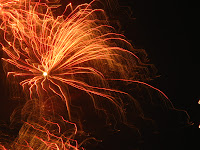The first thing we noticed was how cold it was - 8 Celsius at night! The thermal clothing that we have been carrying and have rarely used has at last come in handy.
Macau is full of tourists and many of them are from Asia. The tourist office had free internet and lots of maps with some great walking tours of the old Portuguese settlements. Many parks, gardens and displays were free which makes a nice change from places that like to charge for everything. The no smoking signs everywhere were most welcome too! The place is so clean with signs stating the fines for littering!

The Guia chapel and lighthouse at the fort.
These signs were on display near the fort and school children had to learn what each meant as they were used during the monsoon season to let everyone know the status of the wind storms.

The hilly narrow streets.

Restored and preserved buildings.

Church of St Dominic.

Ancient and modern!

The red lanterns for Chinese New Year.

The Macau Museum was very interesting and in the olden days (and even into the 1990s) the Chinese residents used to hold cricket fights and bet on the contestants. They had ornate containers made of pottery to house the crickets and they were fed a specific diet to develop their strength. Some were so highly regarded that they had funerals and this is the coffin of a champ and its tomb!


The Venetian


A short walk from our hotel was The Venetian: a brand new casino built by a Las Vegas casino operator. It recently opened and there is still some construction work going on so it is not quite complete. There are already over 30 casinos in tiny Macau!


There are over 11, 000 staff at the casino and on the second there are gondola rides; they go from one end of the indoor canal to the other and along the way you pass by the brand name stores.
 The Lisboa. We also noticed how smoggy it was after Malaysia.
The Lisboa. We also noticed how smoggy it was after Malaysia.The local bus system is great but some of the local buses don't allow big bags so we had to catch a taxi when we left.




































